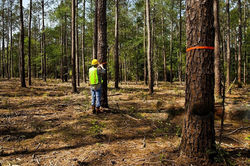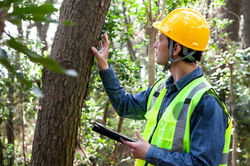
TREE INVENTORY SURVEY
A tree inventory survey is a crucial step in land development projects aiming to:
-
Inform decision-making: It provides valuable information for developers, architects, and landscape architects to make informed decisions about the project design and construction. This information helps minimize tree removal, optimize site planning, and potentially integrate trees into the final development.
-
Comply with regulations: Many local and state regulations require developers to conduct tree inventories before initiating land development projects. These regulations may aim to protect specific tree species, ensure tree preservation during construction, or compensate for unavoidable tree removal.
Here's what a typical tree inventory survey for land development involves:
Pre-fieldwork:
-
Defining the scope: This involves determining the specific information needed based on project goals and regulations. This may include species identification, tree size (diameter at breast height or DBH), health assessment, and crown spread.
-
Obtaining permits: Depending on the location and any protected species, permits from local authorities may be necessary before conducting the survey.
Fieldwork:
-
Tree identification: Each tree is identified by species, using scientific names and common names for clarity.
-
Tree location: The location of each tree is recorded using GPS or other mapping methods. This allows for the creation of an accurate tree map for the project site.
-
Tree size: The diameter at breast height (DBH) is measured for each tree. This is a standard measurement used to estimate tree size and potential value.
-
Health assessment: The overall health of each tree is assessed, including signs of disease, structural defects, and potential threats.
-
Data recording: All collected information is systematically recorded, often using digital data collection tools for efficiency and accuracy.
Post-fieldwork:
-
Data analysis: The collected data is analyzed to understand the overall size, species composition, and health of the tree population on the site.
-
Report generation: A comprehensive report is generated summarizing the findings of the survey. This report typically includes maps, tables, and data analysis to inform decision-making.
Additional considerations:
-
Tree preservation plan: Based on the inventory, a tree preservation plan may be developed to minimize tree removal during construction. This plan may include strategies such as tree protection zones, construction sequencing, and root protection measures.
-
Tree mitigation plan: If unavoidable tree removal is necessary, a tree mitigation plan may be required to compensate for the loss of trees. This typically involves planting new trees elsewhere on the site or contributing to a tree planting program.
By conducting a thorough tree inventory survey, land developers can make informed decisions about their project, comply with regulations, and potentially integrate valuable trees into the final development, creating a more sustainable and aesthetically pleasing outcome.
 |  |
|---|


